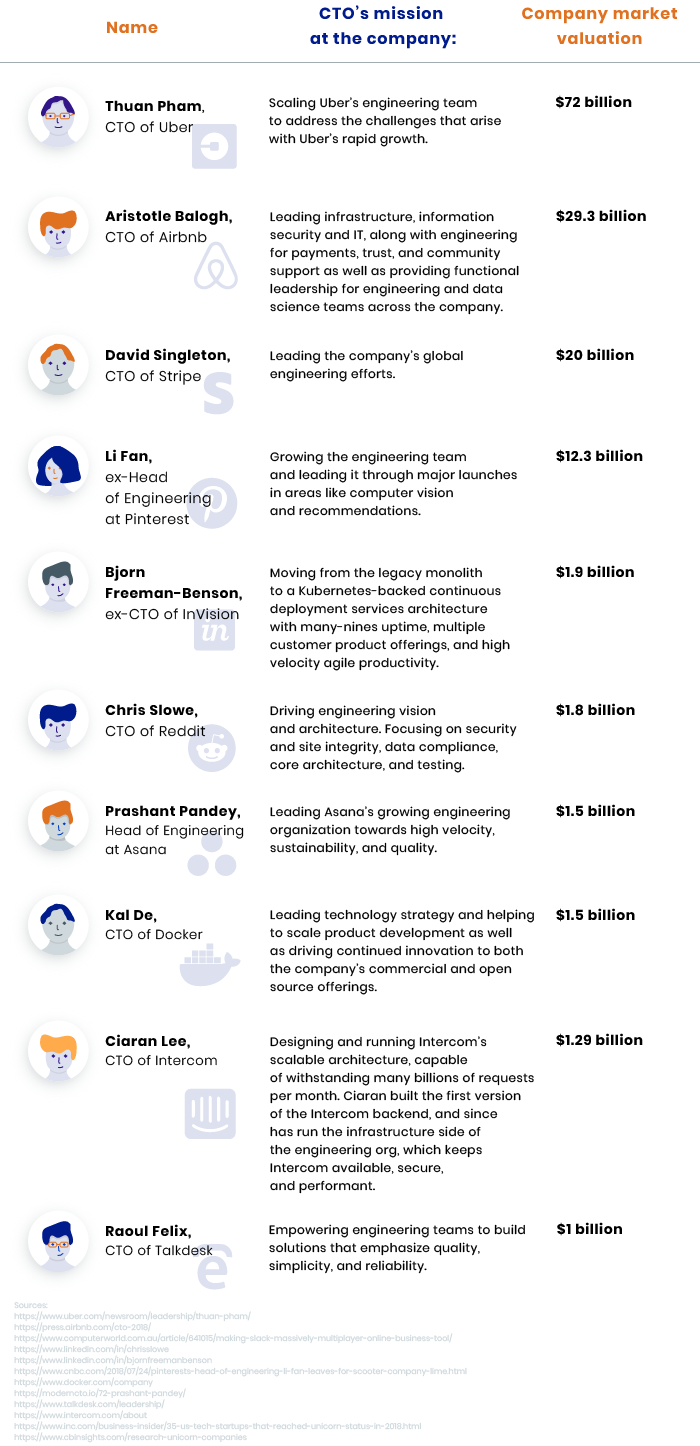-
Product Management
Software Testing
Technology Consulting
-
Multi-Vendor Marketplace
Online StoreCreate an online store with unique design and features at minimal cost using our MarketAge solutionCustom MarketplaceGet a unique, scalable, and cost-effective online marketplace with minimum time to marketTelemedicine SoftwareGet a cost-efficient, HIPAA-compliant telemedicine solution tailored to your facility's requirementsChat AppGet a customizable chat solution to connect users across multiple apps and platformsCustom Booking SystemImprove your business operations and expand to new markets with our appointment booking solutionVideo ConferencingAdjust our video conferencing solution for your business needsFor EnterpriseScale, automate, and improve business processes in your enterprise with our custom software solutionsFor StartupsTurn your startup ideas into viable, value-driven, and commercially successful software solutions -
-
- Case Studies
- Blog
What Is the Role of a CTO at a Tech Startup?
Most modern businesses are technology-driven.
New technologies are emerging all the time, and companies need to adopt them quickly to stay ahead of their competitors. A company that fails to keep up with advances in technology is likely to go broke and withdraw from the market.
The necessity to handle technologies has brought about a new executive position − CTO, which stands for chief technology officer. If you take a look at the leadership of any unicorn startup, you’ll see a CTO among the C-level executives. You too may be in search of a CTO to run the tech side of your business. In this case, you need to fully understand the role a CTO in a company is and what responsibilities this position entails.
In this article, we delve into the subject and define the role of a CTO within a technology startup.
What role does a CTO play at a tech startup?
The very name chief technology officer suggests that the person holding this position is in charge of technology within the organization.
But this CTO role definition is overly general and doesn’t shed much light on the responsibilities of a typical CTO. Moreover, keep in mind that there’s no uniform standard as to what a CTO should actually do. While most organizations stick to the term CTO, some companies use alternative titles (such as head of engineering) for this job.
The CTO role description is vague because the job title often means different things in different companies. What one company expects of their CTO may be entirely different from what the next company expects. The same is true for the position of head or vice president of engineering. To avoid confusion, we’ll use CTO as a general term and focus on the responsibilities of this position and the skills required to carry them out.
Since any technology startup is aimed at growing as much as possible (and, ideally, becoming a unicorn), let’s take a look at the CTO role at ten prominent startups valued over $1 billion each:

As you can see, CTOs at some of the world’s most successful unicorns have mostly management-related missions. But this isn’t the case for recently launched technology startups where there can be only a couple of employees and a CTO is often one of the founders. In fact, there are two major types of CTOs, so let’s take a closer look.
The main types of CTOs
There are plenty of classifications of CTOs, but most of them can’t provide a clear explanation of which responsibilities the CTO role involves. For example, an article by Gartner singles out five CTO personas and explains them really well. But getting the difference between, say, a chief technology innovation officer and a chief business-led innovation technology officer may still be difficult.
The simpler, the better. So we decided to go a different way and classify CTOs by their primary focus within an organization. A CTO can concentrate on:
-
Technical leadership
These CTOs are skilled developers with strong expertise in programming, software architecture design, cloud-based infrastructure configuration, and so on. They do a lot of coding themselves and check the code written by other developers on the team.
-
Operational management
In this case, a CTO is primarily an operational manager that’s responsible for overseeing the engineering team. As usual, the CTO is still an A-level developer with deep knowledge of programming, but purely development-related tasks take the back seat. Instead of coding, these CTOs shape the technology strategy and manage the engineering efforts within their organizations.
As a tech startup grows, the focus of the CTO often shifts from technologies to management. So let’s take a look at how the roles and responsibilities of a CTO change through the tech startup lifecycle.
The evolution of the CTO role at tech startups
It’s important to realize that a CTO has one key mission: making sure that the organization’s technology fully serves its business strategy. No matter if a company is a month-old startup founded in a garage or a billion-dollar unicorn with hundreds of employees, this remains the most important role of a CTO.
Let’s take a look at what stages each technology startup goes through to get a better understanding of how the CTO role in a company evolves.
Stage #1: Business idea
Any technology startup begins with a business idea. At this stage, there might not even be a company. founders gather round to brainstorm, develop their ideas, and draft a viable business plan. Having lots of technical expertise, a CTO (who is often a co-founder) validates the technical feasibility of the business idea and suggests potential technical solutions to implement a software product.
Stage #2: Early stage startup
If a business idea gets the green light from investors, the team gets down to work and starts building a software product. At this point, the CTO is the first (and often the only) developer on the team, so they’re in charge of developing a minimum viable product (MVP) in the shortest time possible.
The roles and responsibilities of a CTO include selecting a technology stack, designing the application architecture, setting up a scalable cloud-based infrastructure (as well as choosing the cloud services provider), and testing the application.
This requires strong programming skills, relevant experience, and the ability to stick to an agile software development workflow. It goes without saying that a tech startup is likely to hire developers, so a CTO doesn’t need to perform all these duties personally. But they still do a lot of coding at an early-stage organization.
Stage #3: Reaching product-market fit
As a technology startup gains ground in the market, it shifts its focus to upgrading its software solution and making it more functional and easier to use in order to attract a larger customer base. To speed up software development, the startup often scales its team and hires more developers.
The CTO role changes accordingly, and management-related responsibilities come into the spotlight: the CTO needs to streamline the feature deployment pipeline so that developers can work productively, ensure security and high up-time of the application, and provide scalable and cost-effective cloud infrastructure.
At this stage, a CTO also needs to manage the growing development team, so they should supervise hiring and establish a software development culture within the organization. The latter is particularly critical, as coding culture ensures that all developers follow uniform standards and practices to write quality code and achieve high productivity.
Stage #4: Growth
Finally, the technology startup achieves success and becomes a large organization with dozens or even thousands of employees. At this point, the CTO leads a large team of developers with an established coding culture and streamlined workflow. So the CTO’s focus shifts to management. If a tech startup wants to roll out a new product line, the CTO may need to form and oversee several development teams working on different projects.
At the same time, a CTO has to build a software product vision. They should keep track of the latest technology trends in the industry and be ready to implement the relevant ones in their software products. Needless to say, to make reasonable choices, a CTO requires deep understanding of business processes and competitors.
The main goal of a CTO at this stage is to retain the competitive advantage by using the most relevant technology.

What skills does a tech startup CTO need?
Even a brief look at the major roles and responsibilities of a CTO is enough to conclude that a chief technology officer needs to have really strong expertise in both software development and operational management. So let’s take an in-depth look at what skills a CTO of a technology startup needs.
The list of skills required of a CTO can be rather long, so to make it easier we’ll divide them by the role a CTO plays. Here are the roles a CTO may need to adopt in a technology startup:
Software architect
The CTO is the leading software architect in a technology startup. They should be able to:
- Design and implement a software architecture
- Select a technology stack
- Design and configure infrastructure
- Select a development toolkit (IDE, etc.)
- Design and implement a database design
- Improve and optimize the application architecture
- Ensure scalability of the application
- Ensure scalability of the infrastructure
- Explore new technologies and decide whether to implement them
Of course, a CTO may not need to fulfil each of these tasks personally; it largely depends on the size of the startup and the number of developers on the team. However, skills of a software architect are essential for CTOs of tech startups. If a CTO doesn’t have these skills, they won’t be able to make wise decisions related to application architecture and infrastructure.
Developer
Before a tech startup gains ground and hires more developers, a CTO may be the only developer. No wonder considerable expertise in software development is a must. A CTO may need to:
- Develop an MVP
- Test an MVP
- Develop APIs
- Write software and API documentation
- Manage third-party services used in the application
Team lead
As a tech startup hires more programmers, the role of a CTO shifts toward leading the development team. Instead of coding, a CTO gets new responsibilities, requiring them to:
- Define and implement development standards according to up-to-date coding methodologies and best practices
- Build an agile development culture
- Set up a development team workflow
- Conduct code reviews
- Perform design reviews
- Break down development tasks
- Supervise hiring of developers
- Mentor newly hired developers
- Communicate with stakeholders
- Determine KPIs of developers
- Monitor developers’ progress
- Manage technical risk
Being a team lead requires not only outstanding coding skills but also good management skills. As a team lead, a CTO needs to communicate with team members and solve any conflicts.
DevOps engineer
Apart from being a development team lead, a CTO needs to be a skilled DevOps engineer. Though DevOps skills may seem redundant for a CTO, they’re instrumental in the success of a tech startup as it needs an efficient deployment pipeline to deliver updates safely and regularly.
A CTO, therefore, has to establish the DevOps culture within their organization, so they should be able to:
- Set up a streamlined deployment pipeline
- Plan software releases
- Manage releases, tags, and versions
- Carry out safe and downtime-proof software releases
System administrator
At early stages of the startup lifecycle, a CTO may need to act as a system administrator to manage their organization’s IT infrastructure. A CTO should be able to:
- Make sure that the company’s data is protected
- Manage the organization’s domains, SSL certificates, and related components
- Develop and implement an internal communication system for the company
- Monitor the performance of the company’s IT infrastructure
As an organization grows, more IT staff are hired to take over these responsibilities. Large organizations often establish a position of chief information officer (CIO). Unlike the CTO, the CIO is in charge of the organization’s internal IT operations.
Senior executive
Finally, don't forget that a CTO is an executive responsible for engineering. At large organizations, CTOs are, first and foremost, senior managers who don’t do any coding themselves but have predominantly management-related responsibilities. A CTO should be able to:
- Participate in strategy planning
- Participate in company management
- Keep track of and analyze the competition to suggest technological innovations
- Suggest ways that technology can help the company be more successful
- Oversee an external workforce (outsourced team)
- Keep track of tech trends in the industry and identify competitive advantages
- Evaluate the technical efficiency of the company
- Oversee IT budgets to optimize expenditures
The role of a senior executive requires not only technical expertise from a CTO but also strong knowledge of how tech businesses work. At this level, being only a tech geek isn’t enough to become an effective CTO for an enterprise.
Wrapping up
The role of a CTO in a software company is crucial for the success of a tech startup − the CTO manages all technology-related issues and makes sure the company’s software product solves problems for the target audience. Hiring a professional CTO, however, can be a real challenge. We’ve mentioned the skill set required from a CTO, and you’ll probably agree it’s huge. No wonder the average salary of a CTO in the US is over $137,000 per year (according to Indeed.com).
Finding the right person capable of managing the technical side of your business may take months, and you should also keep in mind that it’s a rare CTO who can evolve and assume new roles along with the development of your tech startup. That’s why you should consider delegating the responsibilities of a CTO to a reliable technical partner.










